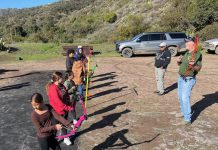Sport fishing grew in popularity throughout the 1930s and early ’40s but came to a halt when the United States entered World War II.
This weekend, a historian will provide the public with a guided tour of the Tuna Club.
The club is opened to the club only once a year, to raise money for the Catalina Island Museum.
The Tuna Club and WWII
Catalina Island experienced dramatic changes and the world famous Tuna Club was directly impacted.
Sport fishing grew in popularity throughout the 1930s and early ’40s but came to a halt when the United States entered World War II.
This weekend, a historian will provide the public with a guided tour of the Tuna Club.
The club is opened to the club only once a year, to raise money for the Catalina Island Museum.
The Tuna Club and WWII
Catalina Island experienced dramatic changes and the world famous Tuna Club was directly impacted.
The U.S. government declared Catalina Island a Federal Military Zone and designated the San Pedro Channel a controlled area for vessels.
The United States Coast Guard ordered the regularly scheduled steamship service to cease. Fishermen could no longer spend their afternoons angling for yellowtail, sea bass and marlin in the waters surrounding the island.
By the summer of 1942, the United States Maritime Service had moved their entire training operation to Avalon.
Nearly every building, including the Tuna Club, was utilized for the war effort. One trainee remembered a huge inflatable lifeboat taking up most of the clubhouse’s library.
With the USMS occupying their clubhouse, Tuna Club meetings were held on the mainland, but few attended.
Thirty-four active club members, including Gen. George S. Patton, served their country in various branches of the military throughout the war.
Despite strict restrictions on fishing in the channel, Tuna Club members still recorded 42 marlin and one broadbill swordfish during the war years.
Once the troops returned home victorious, Americans everywhere were drawn to the “Island of Romance” and the recreational activities it offered.
The Tuna Club moved back into their clubhouse.
Fishing for sport around Catalina Island soon returned to its pre-war popularity.
Tuna Club tours
Tours of the Tuna Club’s historic interior are offered only one day a year, with all of the proceeds benefiting the Catalina Island Museum.
Mike Rivkin, noted historian, author and past president of the Tuna Club, will conduct the tours.
The clubhouse features a number of artifacts, trophies and photographs, documenting the birth of sport fishing and the first rod-and-reel catches of tuna, marlin and broadbill swordfish.
Tours will be offered this Saturday, Aug. 17 at 1, 2, and 3 p.m. Tickets are $30 for members of the museum and $35 for the general public.
The 1 p.m. tour is sold out. Tickets are still available for the 2 and 3 p.m. tours.
For more information or to purchase tickets, the museum may be reached by phone at (310) 510-2414 or at its website: CatalinaMuseum.org.
The Catalina Island Museum is Avalon’s sole institution devoted to art, culture and history.
The museum, its digital theater and store are located on the ground floor of Avalon’s historic Casino and are open seven days a week, from 10 a.m. to 5 p.m.










